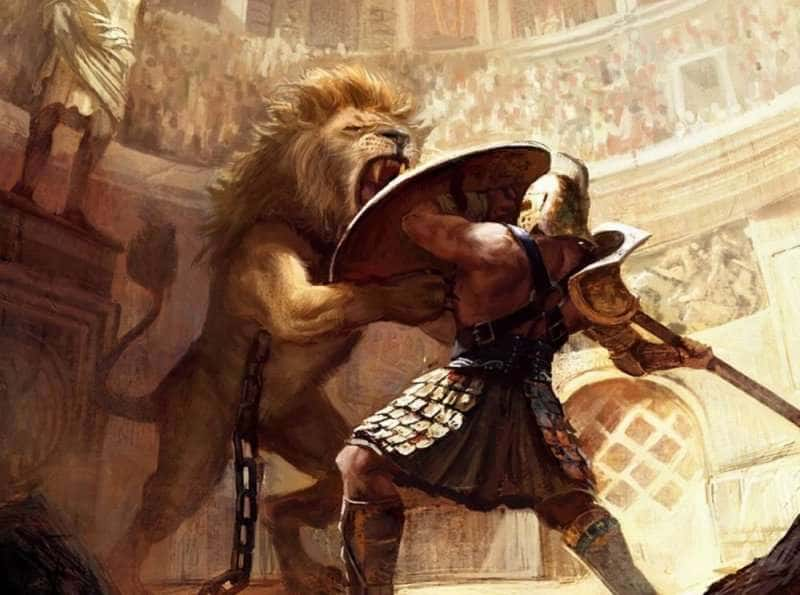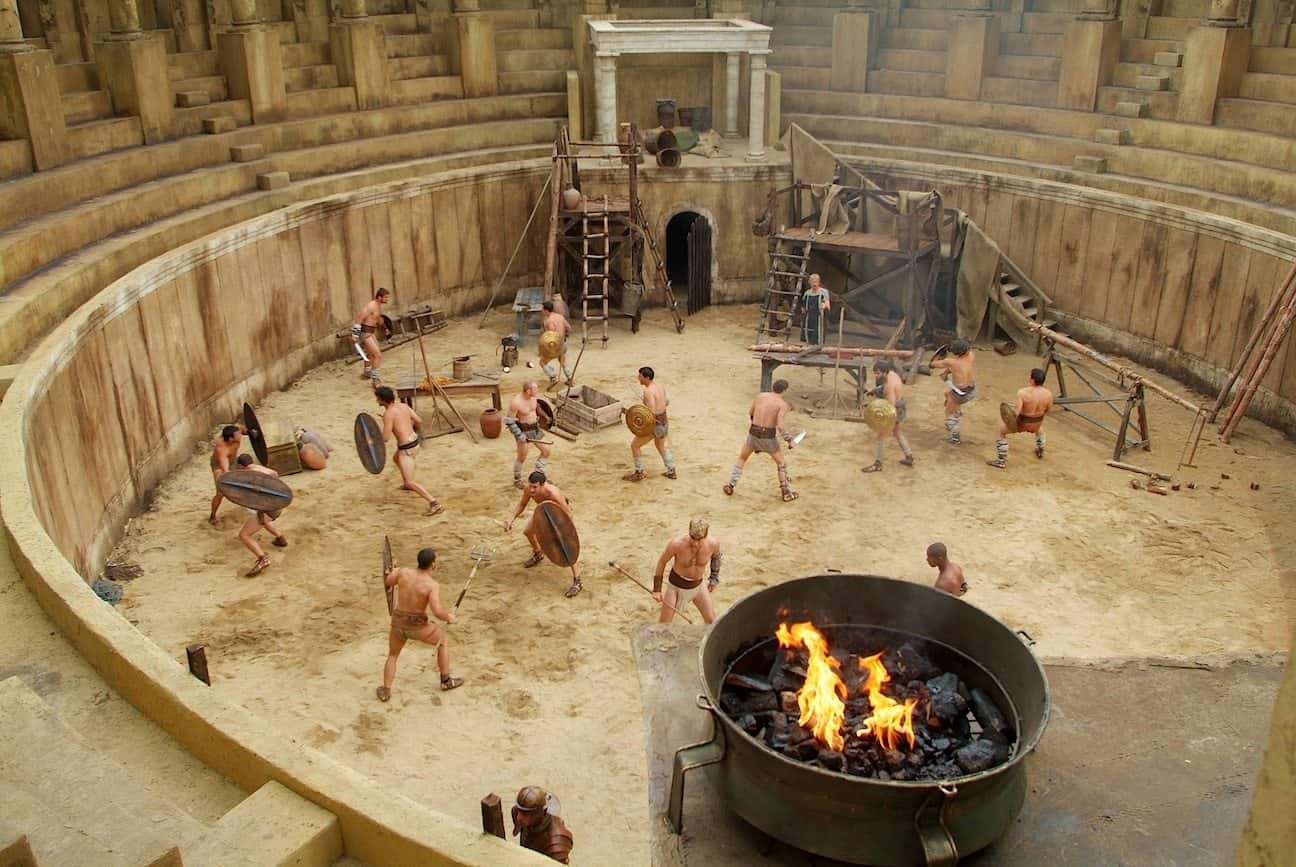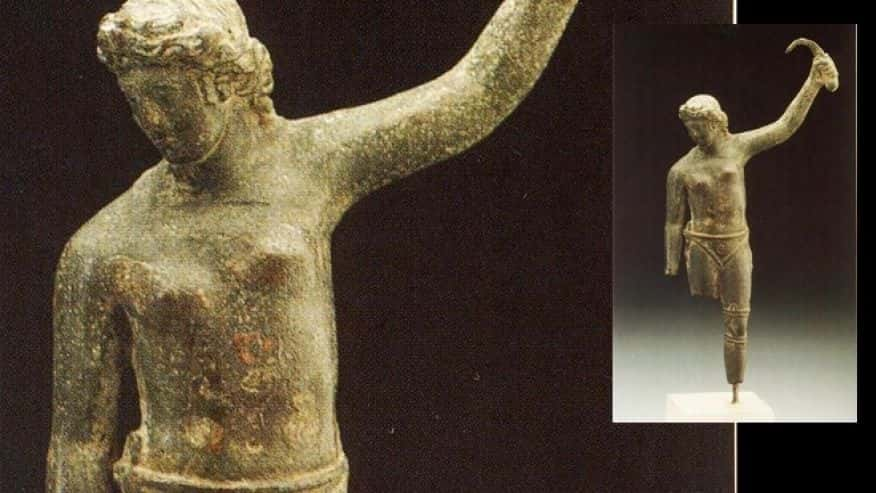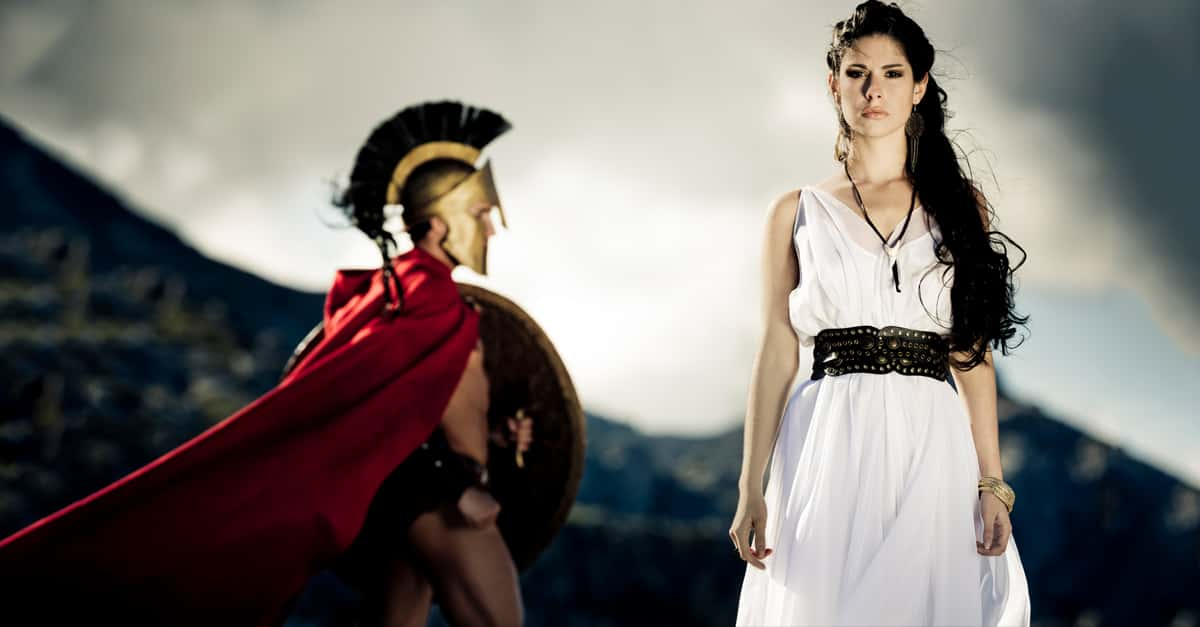Loved by the masses (and often scorned by the elites), Roman gladiators fought on the sands of the Collosseum and smaller venues across the Roman Empire. For more than 650 years, people flocked to arenas to watch these deadly warriors engage in a blood-soaked sport. Here are 43 things you may not know about Roman gladiators.
43. The Precursor
Before gladiators began to fight to the death in the Colosseum, members of the upper class would force slaves to reenact scenes from a person’s life during their funeral. Since most Roman men were soldiers at one time in their life, a slave would be forced to fight, bleed, or even die while reenacting a battle.

42. Bloody Romans
The Romans believed that spilling human blood would purify the soul of the dead. This is why it was so important to make sure slaves died during a funeral.

41. Massive Battle Reenactments
When Julius Caesar came into power, he took this idea of battle reenactments to a whole new level. When his father and daughter both passed away, he ordered hundreds of gladiators to battle one another to the death in their honor.

40. The Crowd Goes Wild
After Caesar put on this massive show, it was all anyone could talk about. Roman citizens loved it, and wanted more. From then on, government officials saw it as a way to win over the hearts of the people, and continued to force gladiators to fight.

39. A Prisoner’s Fate
In the beginning, all gladiators were slaves and prisoners of war from countries that Rome had conquered.

38. The Rudis
Whenever a gladiator won a battle, they got some prize money. If he was able to win enough battles, he could buy back his freedom and return to his home land. On the day he was allowed to be set free, he was given a small wooden sword called a “rudis.”

37. Flamma
A gladiator who went by the name of Flamma was probably the most successful fighter. He was a prisoner of war from Syria, and he participated in 34 battles, which is way more than the average survival time for a gladiator. He was even offered the rudis for his freedom multiple times, but he actually enjoyed the glory of fighting and chose to stay. After a long career of being a gladiator, he died at 30 years old.

36. The Barracks
Next to the Colosseum, there was a training barracks where gladiators lived and trained together. If they were slaves or prisoners of war, they were kept in prison cells. An archeological dig of the barracks showed several skeletons of adults, and a baby. Since some gladiators were allowed to marry, it is possible that some of them raised families in the barracks.
35. Stylized Fighting
Most of the Gladiators had fought in battle before, so they did not necessarily need to be taught how to fight. Similar to modern-day WWE wrestling, they were taught how to make a fight entertaining to the audience. They learned to use wide, open movements and put on a show.


History's most fascinating stories and darkest secrets, delivered to your inbox daily.
34. Carb Up
It’s easy to assume that prisoners in ancient times were nearly starved to death, but the truth is actually the opposite. Gladiators were given a lot of high-energy foods to make sure they were well fed and ready to battle.

33. Gladiators Were Expensive
It cost a lot of money to buy a slave, and it was even more expensive to provide food and housing for a gladiator. So, promoters actually did not want their fighters to die right away, even if the crowd was excited by bloodshed. The longer a gladiator stayed alive, the more money a promoter would make.

32. Costumes and Props
Blacksmiths created a variety of different helmets for the Gladiators to wear. This gave fighter a signature style, and made it easier for people in the audience to identify their favorite fighters. It was meant to give the illusion that the Roman Empire was capturing even more territories than they actually were, if people believed each style of helmet and armor was from another country.

31. Weapons
In the beginning, gladiators only used swords and shields. As time went on, they began to use spears, and stylized weapons like tridents and fishing nets that matched their assigned characters.

30. Fighting Was in Fashion
After several years of watching slaves and prisoners fight as gladiators, many upper class Roman men began to grow jealous, wanting to battle, too. This lead to many upper class men donning armor and fighting in the colosseum.

29. Rules and Regulations
Similar to the rules of modern wrestling, gladiators were categorized in different classes based on their height and weight. Having two warriors of similar ability made fights more fair, and the battles went on longer.
28. Referees
Like all competitive sporting events, gladiator battles had referees. They were especially important in battles involving the upper class, where warriors did not actually need to die. If a gladiator became seriously injured, the referee had the power to stop the fight.

27. Stalemate
Contrary to popular belief, gladiators did not always have to fight to the death. There were times when two warrior were equally matched, and the battle would become long and drawn out. That was considered to be boring for the crowd. So, if no one was dying, the referee could stop the match and declare that it was a tie.

26. Priscus and Verus
These two men were rival gladiators. During one of their most intense battles, they were an equal match to one another. They laid down their weapons and decided on a tie. The crowd went wild, and both fighters won their freedom at the same time.

25. Only the Good Die Young
Most gladiators, whether they were forced into the fight or chose it of their own free will, did not live beyond their 20’s. Just because they don’t always fight to the death does not mean that being a gladiator was safe!

24. The Thumb Myth
In the 2000 movie Gladiator, that the Emperor gestured a thumbs down to signify that he wanted the loser of a fight to die. However, this is not historically accurate. There are images of people giving fighters the thumbs-down, but there is never any written explanation as to why everyone was doing it. Historians just made the assumption on their own.

23. Female Gladiators
Something you never see in the movies is the fact that women were gladiators, too. At first, it was considered sort of a joke, and they usually fought dwarves or animals. Eventually, two female fighters proved they were ready for a real battle. Records show that “Achilla” and “Amazon” fought against one another and came to a draw.

22. Topless
Just like the male gladiators, it was a requirement for the females to be topless. They wore loincloths to cover the bottom half of their bodies, and used a helmet and shield. The crowd could only see the woman’s face in the end, when she pulled her helmet off. It is believed that that portion of the show was meant to be erotic rather than a serious battle.
21. The Ban
In 200 AD, Emperor Septimus Severus decided to ban women from being gladiators.

20. Categories
There were different categories of gladiators, depending on their weapons, armor, skill set, and social class.

19. Celebrity
Certain gladiators became popular among fans. Just like any celebrity, many of these ultra-fit men and women became sex symbols in Roman society. Children even played with dolls made to look like popular gladiators. Roman women actually wore gladiator sweat as perfume.

18. Freelance Warriors
The winners of gladiator battles would win prize money. After a while, free Roman men who needed to earn an income decided to sign a contract to join a training skill and become a gladiator. These were usually ex-soldiers who could not find jobs, or people who wanted the fame and glory.

17. Gladiator Unions
Just like many other jobs, gladiators actually formed unions, called collegia. If a gladiator died, the collegia made sure he had a proper burial. If he had a wife and child, they would put some money together to make sure the family was taken care of.

16. Spartacus
The most famous gladiator was Spartacus. He was a prisoner of war from Thrace, who had been captured by the Romans. Rather than accepting his fate, he convinced 70 other gladiators to rise up and escape. The set even more slaves free and hid in the mountains. The Spartacus rebellion for about a year before the Romans tracked them down and crucified thousands of people who had chosen Spartacus as a new leader.

Spartacus, as depicted in Spartacus (TV Show).
15. Crixus
As Spartacus’ right-hand-man, Crixus was able to get his freedom from being a gladiator. He chose to branch off with his own group and attempted to conquer Southern Italy. However, the Romans hunted him down as well.

Crixus, as depicted in Spartacus (TV Show)
14. The Beast Hunters
In every movie about gladiators, there is always a scene that includes a fight with a vicious animal. Usually, only the “beastiarii” and “venatores” category of fighters fought animals. Since many of them had to be caught, stored, and imported from other countries, it was actually difficult to come up with a large supply of animals for the gladiators to kill, and it needed to be planned far in advance. However, Christians were being punished by the Roman Empire, so there were times when they would put them in the ring with hungry rabid dogs.

13. Suicides
When a prisoner was being thrown to dogs or lions, they were typically only given a dagger to defend themselves. Rather than suffer being torn apart by a wild animal, many of them chose to commit suicide with the knife before the battle began.

12. The Elephant Battle
Sometimes, Roman emperors would use animals as a means to make the show more extreme and entertaining for the audience. In one battle, 20 elephants were pitted against several men.

11. Animals Strike Back
According to the famous philosopher Cicero, one lion was able to kill 200 men before one of the gladiators put it down. In another story, a herd of elephants ran into the crowd, trampling the audience rather than the prisoners.

10. Overkill
On the first 100 days after opening day, in the newly built Roman Colosseum, 9,000 different exotic animals were killed. This included elephants, crocodiles, ostriches, bears, tigers, bulls, giraffes, hippos, rhinos, and lions. During another festival, an additional 11,000 animals were killed. This mass killing of animals actually contributed to the extinction of these species in the Mediterranean area.

9. One of the Guys
Some of the Emperors would actually participate in gladiator battles, in order to get people to like them. Usually, they would battle animals on top of elevated platforms. This way, they were relatively safe, and it was easy to kill the defenseless creatures before returning to their seats to enjoy the rest of the show.

8. Commodus
There was one Emperor who enjoyed participating in the gladiator games a little too much. Commodus would show up to the Colosseum whenever he wanted, a challenge men to battle. He never seemed to care about the showmanship aspect of the fighting gladiators, and went right for the kill. There were even moments when he brought in disabled people off the street in order to kill them in front of an audience. Obviously, this guy was a sadistic murderer, and thankfully, he was assassinated in 192 AD.
7. Keep The Ladies Away
Perhaps the male spectators were afraid that their wives would enjoy the show of half-naked physically fit men a little too much. Women were only allowed to sit in the very back row. This meant that they could not see the finer details of the gladiator’s six-pack abs. It is said that there was an anxiety that women would cheat on their husbands if they got too close. However, it was perfectly fine for men to watch the topless female gladiators in the front row.

6. Prostitution Side-Hustles
While the history books cannot confirm if gladiators really became sex workers on the side or not, the practice would have most likely been kept a secret. However, one clue may answer the debate. The Roman word “lanista,” which was the name of the trainers who taught the gladiators how to fight, was also used as slang for the word meaning “pimp.” Many of the gladiators were ex-soldiers who were in their teens and 20’s, and they did not have the opportunity to socialize. They were also desperate for money to stay alive, buy their freedom, and go home.

5. Can’t We All Just Get Along?
The very first person of note to object to the gladiator games was a man named Telemachus. He was a Christian monk from Egypt, and he evangelized to people that all of the violence and the bloodshed needed to stop. He encouraged people to bring Jesus into their hearts. The public responded by stoning him to death.

4. Natural Disaster
Over the years, the Colosseum had a lot of issue with Mother Nature. It was hit by lightning, caught on fire, and even went through two different earthquakes. This destroyed parts of the stadium. People continued to go to the games, but as it became more damaged, it became a less appealing place to hang out to watch a fight.

3. Financial Troubles
At one point in time, the gladiator battles were running the Roman economy. Common people used their money to buy tickets, and wealthy patrons paid for their favorite warriors. As the economy began to suffer, so did the games. Eventually, the economy got so bad, that people began to steal anything made from gold or metals in order to scrap it and make some money.

2. Affairs
Empress Faustina, the wife of Emperor Marcus Aurelius, had such vivid fantasies about a Roman gladiator that she actually suffered physiological pain and insomnia. Several historians have reported that she carried on an affair with this gladiator and several others, potentially leading to the conception of Commodus.
She eventually confessed her passions to her husband, and Marcus sought the council of his soothsayers. On their advice, Marcus ordered the gladiator executed and demanded that Faustina bathe in his blood before she lay with Marcus.

1. Christian Shut-Down
When Emperor Constantine decided that Christianity would be the official religion of Rome, that officially ended the gladiator games. At first, people were disappointed, but once they learned to have compassion through Christian teachings, they began to actually feel guilty about the barbaric practice. Over time, people stopped missing it.
















